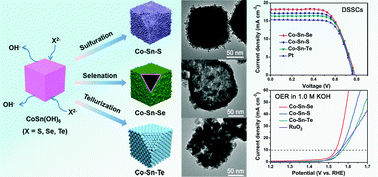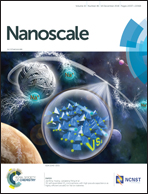Construction of uniform Co–Sn–X (X = S, Se, Te) nanocages with enhanced photovoltaic and oxygen evolution properties via anion exchange reaction†
Abstract
The development of highly efficient electrocatalysts has attracted increasing attention in the field of electrochemical energy conversion. Therefore, we report a simple self-template method to construct Co–Sn–X (X = S, Se, Te) nanocages through the anion exchange reaction of CoSn(OH)6 nanocubes with chalcogenide ions under mild solvothermal conditions. Benefiting from advantageous compositional features and well-designed architectures, the obtained Co–Sn–X (X = S, Se, Te) nanocages display enhanced electrocatalytic activity for dye-sensitized solar cells (DSSCs) and the oxygen evolution reaction (OER) in an alkaline electrolyte. Remarkably, the Co–Sn–Se nanocages as the counter electrode (CE) catalyst deliver a prominent power conversion efficiency (PCE) of 9.25% for DSSCs compared with Pt CE (8.19%). Furthermore, when used as an OER catalyst, the Co–Sn–Se nanocages also exhibit outstanding electrocatalytic activity in terms of their low overpotential of 304 mV at the current density of 10 mA cm−2 and long-term stability in 1.0 M KOH solution. This work provides wide prospects for the rational design and synthesis of high-performance transition metal chalcogenide-based electrocatalysts for future energy conversion systems.



 Please wait while we load your content...
Please wait while we load your content...